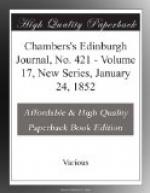* * * * *
[Footnote 3: In the sacristy of the cathedral at Aix-la-Chapelle is still preserved, among other relics of this great prince, an immense ivory hunting-horn; and ‘Charlemagne’s chess-men,’ which still exist, form part of the collection of works of art at Cologne.]
[Footnote 4: See an article on the Aberdeen Combworks, No. 396.]
BLIGHTED FLOWERS.
The facts of the following brief narrative, which are very few and of but melancholy interest, became known to me in the precise order in which they are laid before the reader. They were forced upon my observation rather than sought out by me; and they present, to my mind at least, a touching picture of the bitter conflict industrious poverty is sometimes called upon to wage with ’the thousand natural shocks which flesh is heir to.’
It must be now eight or nine years since, in traversing a certain street, which runs for nearly half a mile in a direct line southward, I first encountered Ellen——. She was then a fair young girl of seventeen, rather above the middle size, and with a queen-like air and gait which made her appear taller than she really was. Her countenance, pale but healthy, and of a perfectly regular and classic mould, was charming to look upon from its undefinable expression of lovableness and sweet temper. Her tiny feet tripped noiselessly along the pavement, and a glance from her black eye sometimes met mine like a ray of light, as, punctually at twenty minutes to nine, we passed each other near —— House, each of us on our way to the theatre of our daily operations. She was an embroideress, as I soon discovered from a small stretching-frame, containing some unfinished work, which she occasionally carried in her hand. She set me a worthy example of punctuality, and I could any day have told the time to a minute without looking at my watch, by marking the spot where we passed each other. I learned to look for her regularly, and before I knew her name, had given her that of ‘Minerva,’ in acknowledgment of her efficiency as a mentor.
A year after the commencement of our acquaintance, which never ripened into speech, happening to set out from home one morning a quarter of an hour before my usual time, I made the pleasing discovery that my juvenile Minerva had a younger sister, if possible still more beautiful than herself. The pair were taking an affectionate leave of each other at the crossing of the New Road, and the silver accents of




